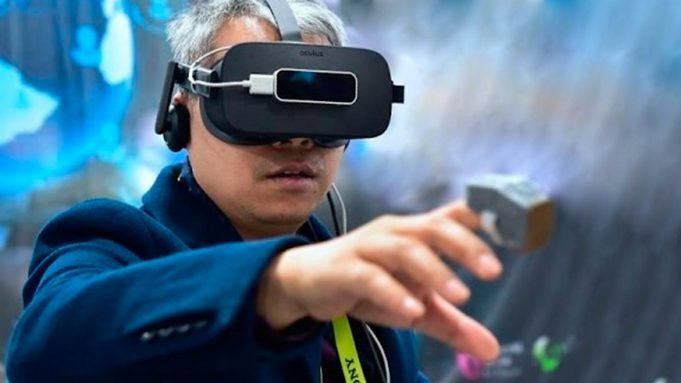 Deep in the basement of the Sands Expo Hall at CES was an area of emerging technologies called Eureka Park, which had a number of VR start-ups hoping to connect with suppliers, manufacturers, investors, or media in order to launch a product or idea. There was an early-stage haptic start-up called Go Touch VR showing off a haptic ring that simulated the type of pressure your finger might feel when pressing a button. I’d say that their demo was still firmly within the uncanny valley of awkwardness, but CEO Eric Vezzoli has a Ph.D. in haptics and was able to articulate an ambitious vision and technical roadmap towards a low-cost and low-fidelity haptics solution.
Deep in the basement of the Sands Expo Hall at CES was an area of emerging technologies called Eureka Park, which had a number of VR start-ups hoping to connect with suppliers, manufacturers, investors, or media in order to launch a product or idea. There was an early-stage haptic start-up called Go Touch VR showing off a haptic ring that simulated the type of pressure your finger might feel when pressing a button. I’d say that their demo was still firmly within the uncanny valley of awkwardness, but CEO Eric Vezzoli has a Ph.D. in haptics and was able to articulate an ambitious vision and technical roadmap towards a low-cost and low-fidelity haptics solution.
LISTEN TO THE VOICES OF VR PODCAST
Vezzoli quoted haptics guru Vincent Hayward as claiming that haptics is an ‘infinite degree of freedom problem’ that can never be 100% solved, but that the best approach to get as close as possible is to trick the brain. Go Touch VR is aiming to provide a minimum viable way to trick the brain starting with simulating user interactions like button presses.
I had a chance to catch up with Vezzoli at CES where we talked about the future challenges of haptics in VR including the 400-800 Hz frequency response of fingers, the mechanical limits of nanometer-accuracy of skin displacement, the ergonomic limitations of haptic suits, and the possibility of fusing touch and vibrational feedback with force feedback haptic exoskeletons.
Support Voices of VR
- Subscribe on iTunes
- Donate to the Voices of VR Podcast Patreon
Music: Fatality & Summer Trip







